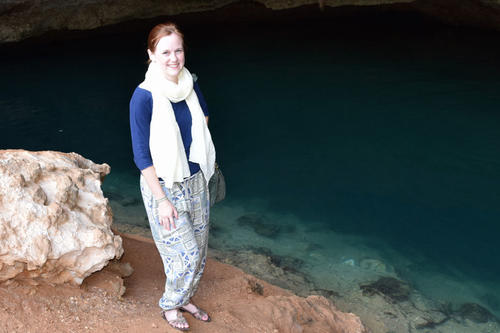The Switzerland of the Middle East
Letter from Oman! On an excursion Salome Bader gets to know Omani hospitality.
Nov 11, 2015
The Bimah Sinkhole, a cavity in the ground about two hours’ drive away from Muscat, is at least 60 meters deep. There are various local legends surrounding how the sinkhole formed.
Image Credit: Private
Guests relax and dangle their feet at the Bimah Sinkhole.
Image Credit: Private
Two weeks after arriving, we explore the area outside of Muscat for the first time. About two hours away by car is the Bimah Sinkhole, also known as Hawiyat Najm (Falling Star) Park. While one Omani legend holds that a meteorite once struck here, creating the hole, geologists assume that the lower strata of rock were eroded by water, and that the earth above collapsed at some point. However the hole was formed, it is very impressive. Salt water from the nearly beach and fresh water from the mountains combine in the sinkhole, which is at least 60 meters deep at its deepest point.
An Unusual Foot Massage
The color of the water changes depending on how much salt water is in the hole and how many people stir the water up. It is relatively clear today because it rained earlier – our first rain since arriving in Oman – so not many people have been here so far. At the edge of the sinkhole, we meet an Omani named Khaled. As we learn later on, he is working as a guard at the park this week. After a few interesting stories about the sinkhole, he invites us to have qahwa: coffee spiced with cardamom. He urges us to stop by at the front gate before we go back. But first and foremost it’s all about swimming, jumping from lower rocks around the sinkhole and letting the little fish in the water massage our feet – you have to pay for that kind of treatment elsewhere, but here, it’s free.
Dates and Qahwa at the Guard Hut
Afterward, we stop by to see Khaled in his guard hut. He already has visitors, a few French people with whom he talks half in French and half in English. There is another friend of his inside the building. He greets us with a German “Guten Tag.” Surprised, we learn that the friend has been to Germany several times, so he has naturally picked up a few words here and there. German words pepper the conversation as we take a seat on the floor and are served dates and qahwa. We talk for almost two hours, on topics such as cultures – specifically Omani and German culture – excursion possibilities in Oman, and the effects of globalization. The two Omanis tell us how important it is to them to forge ties with tourists, show them their culture and traditions, and correct the often very negative image of the Arab world that is presented in the media.
We agree with that, and also tell them about our impression of Oman so far: The people are friendlier than we have ever seen before, especially toward guests. We have always been welcomed with open arms, treated with respect and tolerance, and everyone has explained things to us very patiently, even when we still didn’t understand the Arabic word after three tries. The people here are very open and tolerant; all it takes to experience Omani hospitality is a little time and the courage to strike up a conversation. In this way, you can also get to know the culture, the country, and the people properly – it is not without reason that Oman is sometimes called “the Switzerland of the Middle East.”


